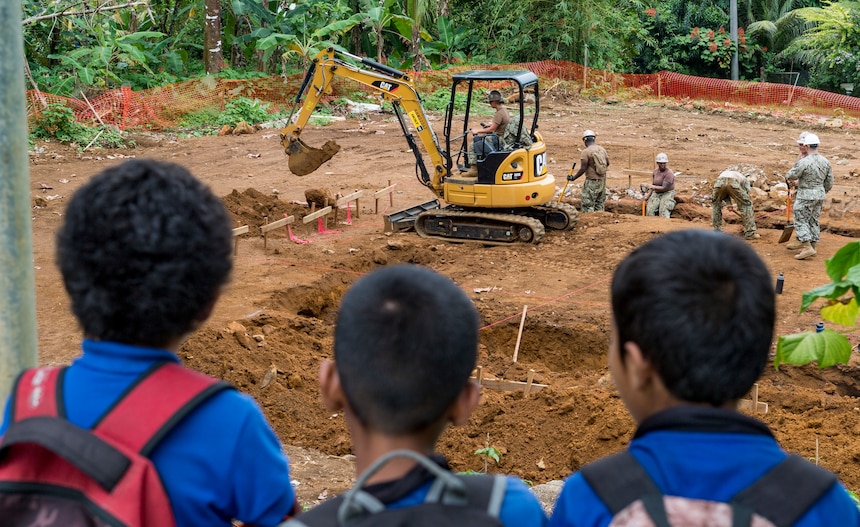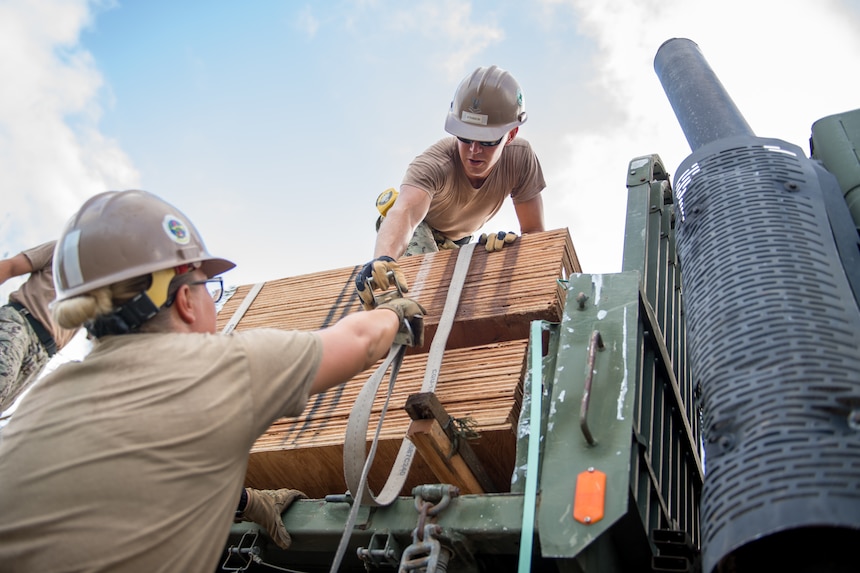Building and Fighting in the Pacific
By ggranger, / Published June 19, 2019
Story by MC2 Kenneth Rodriguez Santiago, U.S. Pacific Fleet Public Affairs
PEARL HARBOR Throughout World War II, approximately 250,000 forward-deployed Seabees constructed and repaired bases in Guadalcanal, communication stations in Papua New Guinea and bunkers to assist the war effort. Today, the number of forward-deployed Seabees operating in the Pacific is around 800. They operate in the Philippines, Timor-Leste, Marshall Islands, Federated States of Micronesia, Palau, Vietnam, Japan, Sri Lanka, Thailand, Pohnpei Palawan, Indonesia, Diego Garcia, Guam, South Korea, San Clemente, California and Hawaii building schools, hospitals, and providing humanitarian assistance.
After the attack on Pearl Harbor, Rear Adm. Ben Moreell, U.S. Navy chief of the bureau of yards and docks, recommended establishing Naval Construction Battalions because international law prohibited civilian contractors from working overseas to build military installations. In early January 1942, the first construction units, dubbed Seabees, organized and quickly deployed to Bora Bora.
Capt. Steven Stasick, commodore, Thirtieth Naval Construction Regiment (NCR), located in Guam, said that Seabees play a crucial role in supporting the Fleet and U.S. Marine Corps (USMC) combatant commands missions.
While Seabees work tirelessly to ensure a fully trained and seamless cooperation in the event of a conflict, expanding collaboration and cooperation with allies and partners in the region is an important part of the Seabee mission around the world, especially in the Indo-Pacific, he said. There is no better signal of our desire to maintain a free and open Indo-Pacific than U.S. Naval operations in the region.
Seabee detachments provide local populations with construction efforts such as building new schools and medical clinics in difficult to reach or remote locations in an effort to enhance quality of life for residents of local communities. Stasick highlighted how the Seabees impact to communities throughout the Pacific has helped establish lasting relationships that are valuable to continued cooperation today.
The work the Seabees perform is invaluable to a wide range of audiences, said Stasick. The Seabees provide critical infrastructure, which benefits the entire Indo-Pacific. Their physical presence is a tangible means of demonstrating U.S. commitment and partnership.
This year alone, Seabees are working on more than 40 construction projects in at least 17 locations throughout the Indo-Pacific and continue to work with local military and partner nation construction teams. They have detachments and exercises from San Clemente Island, California to Diego Garcia, located in the Indian Ocean.
[caption id="attachment_17897" align="alignnone" width="618"]

190507-N-LN093-1065
POHNPEI, Federated States of Micronesia (May 7, 2019) – Local children observe Sailors assigned to Naval Mobile Construction Battalion (NMCB) 4, Construction Civic Action Detail, Federated States of Micronesia (CCAD FSM), excavate soil for concrete footers during the construction of the new Nan U Medical Dispensary in Pohnpei, Federated States of Micronesia, May 7. The United States has been sending CCAD Teams to the FSM for decades to continue strengthening the enduring friendship and lasting partnership between the two countries. NMCB 4, provides expeditionary construction and engineering capabilities that includes maintenance and operation of expeditionary bases and facilities, tactical sustainment bridging, humanitarian assistance through construction civic action details and civic action teams and theater disaster response capabilities in the U.S. 7th Fleet area of operations. (U.S. Navy photo by Mass Communication Specialist 2nd Class Jasen Moreno-Garcia

181213-N-VR594-091 TINIAN, Commonwealth of the Northern Mariana Islands (Dec. 13, 2018) Builder 2nd Class Emma McCarthy, from Springville, N.Y., and Builder 2nd Class Cody Atkinson, from Placerville, Calif., both assigned to Naval Mobile Construction Battalion 1, Detachment Guam, secure plywood on a Medium Tactical Vehicle Replacement using a ratchet strap while constructing an emergency temporary roof for a home. Service members from Joint Region Marianas and U.S. Indo-Pacific Command are providing Department of Defense support to the Commonwealth of the Northern Mariana Islands' civil and local officials as part of the Federal Emergency Management Agency-supported Super Typhoon Yutu recovery efforts. (U.S. Navy photo by Mass Communication Specialist 2nd Class Kelsey J. Hockenberger)

